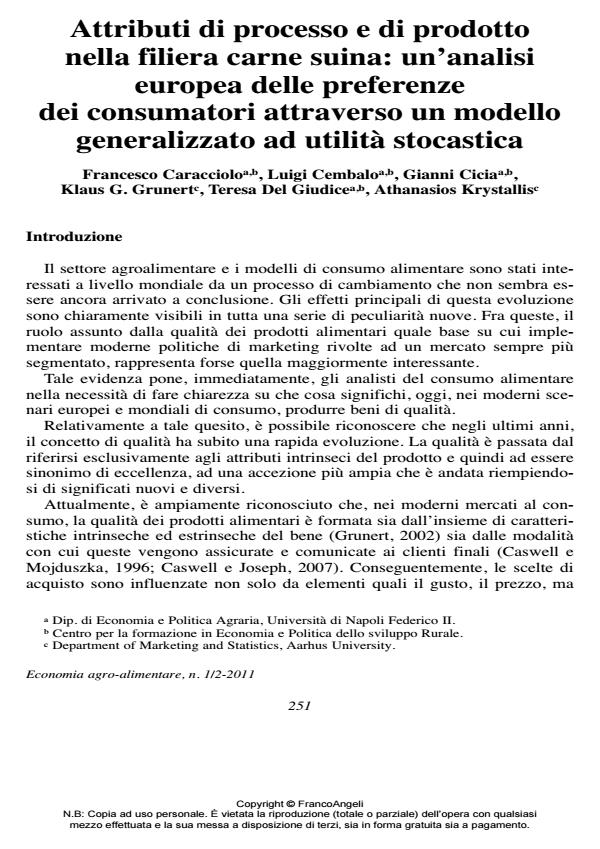European preferences for pork product and process attributes: a generalized random utility model for ranked outcome
Journal title ECONOMIA AGRO-ALIMENTARE
Author/s Francesco Caracciolo, Luigi Cembalo, Gianni Cicia, Klaus G. Grunert, Teresa Del Giudice, Athanasios Krystallis
Publishing Year 2011 Issue 2011/1-2 Language Italian
Pages 20 P. File size 626 KB
DOI 10.3280/ECAG2011-001012
DOI is like a bar code for intellectual property: to have more infomation
click here
Below, you can see the article first page
If you want to buy this article in PDF format, you can do it, following the instructions to buy download credits

FrancoAngeli is member of Publishers International Linking Association, Inc (PILA), a not-for-profit association which run the CrossRef service enabling links to and from online scholarly content.
This article evaluates consumers’ preferences among different pig production systems using a generalized random-parameter logit model for ranked outcome. The aim is to indagate whether process attributes are considered relevant by European consumers. Differences of preferences across subpopulations, among northern and mediterranean European countries, are also tested. The study’s background includes consumers’ concern of both farm animal welfare and environmental impact of livestock production. A self-administered structured electronic survey was developed to investigate product and process attributes of pork meat. It was completed by a sample of 2,437 representative individuals from five European countries. Each respondent made 14 choices, rank-ordering 15 pig production profiles in terms of their individual preference. The choice was organized around a fractional factorial main effect orthogonal design. Each profile consists of five different attributes, including product’s and process’s ones: stocking density and floor type process attributes have been included as proxies of animal welfare production characteristics; impact on soil, air and water were included to underline environmental related process attributes; fat contents and chain type/product were used to include in the choice set also traditional product attributes. A generalization of conditional logit model for ranked outcomes was implemented, accounting for heterogeneity and correlation among the respondent’s choices. Our analysis highlights the fundamental strategic role played by the process attributes considered. Such an influence in choices, however, does not seem connected to psychographic or particular lifestyle variables. This might suggest that a floor type more conducive to animal welfare and considerable effort made by the farm to limit environmental impact both represent for consumers indirect indicators of food health and safety. In addition, for a mature product, as is pork in current European consumption models, to focus on intrinsic attributes such as fat quantity and quality would not appear efficient. This is confirmed by the result obtained for the “obese” segment, for whom fat quality is unimportant in their choice to purchase pork.
Keywords: Pork consumption, choice models, consumer preferences, market segmentation
Jel codes: Q13, C25
- Le preferenze dei consumatori della provincia di Trieste per l'olio extra vergine di oliva d'alta gamma Francesco Caracciolo, Teresa Del Giudice, Alessandro Esposito, Sandro Sillani, in ECONOMIA AGRO-ALIMENTARE 1/2014 pp.139
DOI: 10.3280/ECAG2014-001007 - Consumer perceptions of food safety risk: Evidence from a segmentation study in Albania Edvin Zhllima, Drini Imami, Maurizio Canavari, in Journal of Integrative Agriculture /2015 pp.1142
DOI: 10.1016/S2095-3119(14)60997-7
Francesco Caracciolo, Luigi Cembalo, Gianni Cicia, Klaus G. Grunert, Teresa Del Giudice, Athanasios Krystallis, Attributi di processo e di prodotto nella filiera carne suina: un’analisi europea delle preferenze dei consumatori attraverso un modello generalizzato ad utilità stocastica in "ECONOMIA AGRO-ALIMENTARE" 1-2/2011, pp , DOI: 10.3280/ECAG2011-001012